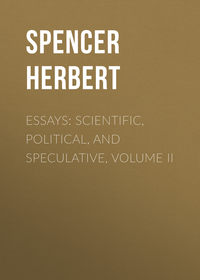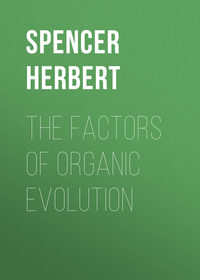 полная версия
полная версияThe Principles of Biology, Volume 1 (of 2)
The relation between growth and supply of available nutriment, is too familiar a relation to need proving. There are, however, some aspects of it that must be contemplated before its implications can be fully appreciated. Among plants, which are all constantly in contact with the gaseous, liquid, and solid matters to be incorporated with their tissues, and which, in the same locality, receive not very unlike amounts of light and heat, differences in the supplies of available nutriment have but a subordinate connexion with differences of growth. Though in a cluster of herbs springing up from the seeds let fall by a parent, the greater sizes of some than of others is doubtless due to better nutrition, consequent on accidental advantages; yet no such interpretation can be given of the contrast in size between these herbs and an adjacent tree. Other conditions here come into play: one of the most important being, an absence in the one case, and presence in the other, of an ability to secrete such a quantity of ligneous fibre as will produce a stem capable of supporting a large growth. Among animals, however, which (excepting some Entozoa) differ from plants in this, that instead of bathing their surfaces the matters they subsist on are dispersed, and have to be obtained, the relation between available food and growth is shown with more regularity. The Protozoa, living on microscopic fragments of organic matter contained in the surrounding water, are unable, during their brief lives, to accumulate any considerable quantity of nutriment. Polyzoa, having for food these scarcely visible members of the animal kingdom, are, though large compared with their prey, small as measured by other standards; even when aggregated into groups of many individuals, which severally catch food for the common weal, they are often so inconspicuous as readily to be passed over by the unobservant. And if from this point upwards we survey the successive grades of animals, it becomes manifest that, in proportion as the size is great, the masses of nutriment are either large, or, what is practically the same thing, are so abundant and so grouped that large quantities may be readily taken in. Though, for example, the greatest of mammals, the arctic whale, feeds on such comparatively small creatures as the acalephes and molluscs floating in the seas it inhabits, its method of gulping in whole shoals of them and filtering away the accompanying water, enables it to secure great quantities of food. We may then with safety say that, other things equal, the growth of an animal depends on the abundance and sizes of the masses of nutriment which its powers enable it to appropriate. Perhaps it may be needful to add that, in interpreting this statement, the proportion of competitors must be taken into account. Clearly, not the absolute, but the relative, abundance of fit food is the point; and this relative abundance very much depends on the number of individuals competing for the food. Thus all who have had experience in fishing in Highland lochs, know that where the trout are numerous they are small, and that where they are comparatively large they are comparatively few.
What is the relation between growth and expenditure of energy? is a question which next presents itself. Though there is reason to believe such a relation exists, it is not very readily traced: involved as it is with so many other relations. Some contrasts, however, may be pointed out that appear to give evidence of it. Passing over the vegetal kingdom, throughout which the expenditure of force is too small to allow of such a relation being visible, let us seek in the animal kingdom, some case where classes otherwise allied, are contrasted in their locomotive activities. Let us compare birds on the one hand, with reptiles and mammals on the other. It is an accepted doctrine that birds are organized on a type closely allied to the reptilian type, but superior to it; and though in some respects the organization of birds is inferior to that of mammals, yet in other respects, as in the greater heterogeneity and integration of the skeleton, the more complex development of the respiratory system, and the higher temperature of the blood, it may be held that birds stand above mammals. Hence were growth dependent only on organization, we might infer that the limit of growth among birds should not be much short of that among mammals; and that the bird-type should admit of a larger growth than the reptile-type. Again, we see no manifest disadvantages under which birds labour in obtaining food, but from which reptiles and mammals are free. On the contrary, birds are able to get at food that is fixed beyond the reach of reptiles and mammals; and can catch food that is too swift of movement to be ordinarily caught by reptiles and mammals. Nevertheless, the limit of growth in birds falls far below that reached by reptiles and mammals. With what other contrast between these classes, is this contrast connected? May we not suspect that it is connected (partially though not wholly) with the contrast between their amounts of locomotive exertion? Whereas mammals (excepting bats, which are small), are during all their movements supported by solid surfaces or dense liquids; and whereas reptiles (excepting the ancient pterodactyles, which were not very large), are similarly restricted in their spheres of movement; the majority of birds move more or less habitually through a rare medium, in which they cannot support themselves without relatively great efforts. And this general fact may be joined with the special fact, that those members of the class Aves, as the Dinornis and Epiornis, which approached in size to the larger Mammalia and Reptilia, were creatures incapable of flight – creatures which did not expend this excess of force in locomotion. But as implied above, and as will presently be shown, another factor of importance comes into play; so that perhaps the safest evidence that there is an antagonism between the increase of bulk and the quantity of motion evolved is that supplied by the general experience, that human beings and domestic animals, when overworked while growing, are prevented from attaining the ordinary dimensions.
One other general truth concerning degrees of growth, must be set down. It is a rule, having exceptions of no great importance, that large organisms commence their separate existences as masses of organic matter more or less considerable in size, and commonly with organizations more or less advanced; and that throughout each organic sub-kingdom, there is a certain general, though irregular, relation between the initial and the final bulks. Vegetals exhibit this relation less manifestly than animals. Yet though, among the plants that begin life as minute spores, there are some which, by the aid of an intermediate form, grow to large sizes, the immense majority of them remain small. While, conversely, the great Monocotyledons and Dicotyledons, when thrown off from their parents, have already the formed organs of young plants, to which are attached stores of highly nutritive matter. That is to say, where the young plant consists merely of a centre of development, the ultimate growth is commonly insignificant; but where the growth is to become great, there exists to start with, a developed embryo and a stock of assimilable matter. Throughout the animal kingdom this relation is tolerably manifest though by no means uniform. Save among classes that escape the ordinary requirements of animal life, small germs or eggs do not in most cases give rise to bulky creatures. Where great bulk is to be reached, the young proceeds from an egg of considerable bulk, or is born of considerable bulk ready-organized and partially active. In the class Fishes, or in such of them as are subject to similar conditions of life, some proportion usually obtains between the sizes of the ova and the sizes of the adult individuals; though in the cases of the sturgeon and the tunny there are exceptions, probably determined by the circumstances of oviposition and those of juvenile life. Reptiles have eggs that are smaller in number, and relatively greater in mass, than those of fishes; and throughout this class, too, there is a general congruity between the bulk of the egg and the bulk of the adult creature. As a group, birds show us further limitations in the numbers of their eggs as well as farther increase in their relative sizes; and from the minute eggs of the humming-bird up to the immense ones of the Epiornis, holding several quarts, we see that, speaking generally, the greater the eggs the greater the birds., Finally, among mammals (omitting the marsupials) the young are born, not only of comparatively large sizes, but with advanced organizations; and throughout this sub-division of the Vertebrata, as throughout the others, there is a manifest connexion between the sizes at birth and the sizes at maturity. As having a kindred meaning, there must finally be noted the fact that the young of these highest animals, besides starting in life with bodies of considerable sizes, almost fully organized, are, during subsequent periods of greater or less length, supplied with nutriment – in birds by feeding and in mammals by suckling and afterwards by feeding. So that beyond the mass and organization directly bequeathed, a bird or mammal obtains a further large mass at but little cost to itself.
Were exhaustive treatment of the topic intended, it would be needful to give a paragraph to each of the incidental circumstances by which growth may be aided or restricted: – such facts as that an entozoon is limited by the size of the creature, or even the organ, in which it thrives; that an epizoon, though getting abundant nutriment without appreciable exertion, is restricted to that small bulk at which it escapes ready detection by the animal it infests; that sometimes, as in the weazel, smallness is a condition to successful pursuit of the animals preyed upon; and that in some cases, the advantage of resembling certain other creatures, and so deceiving enemies or prey, becomes an indirect cause of restricted size. But the present purpose is simply to set down those most general relations between growth and other organic traits, which induction leads us to. Having done this, let us go on to inquire whether these general relations can be deductively established.
§ 44. That there must exist a certain dependence of growth on organization, may be shown a priori. When we consider the phenomena of Life, either by themselves or in their relations to surrounding phenomena, we see that, other things equal, the larger the aggregate the greater is the needful complexity of structure.
In plants, even of the highest type, there is a comparatively small mutual dependence of parts: a gathered flower-bud will unfold and flourish for days if its stem be immersed in water; and a shoot cut off from its parent-tree and stuck in the ground will grow. The respective parts having vital activities that are not widely unlike, it is possible for great bulk to be reached without that structural complexity required for combining the actions of parts. Even here, however, we see that for the attainment of great bulk there requires such a degree of organization as shall co-ordinate the functions of roots and branches – we see that such a size as is reached by trees, is not possible without a vascular system enabling the remote organs to utilize each other's products. And we see that such a co-existence of large growth with comparatively low organization as occurs in some of the marine Algæ, occurs where the conditions of existence do not necessitate any considerable mutual dependence of parts – where the near approach of the plant to its medium in specific gravity precludes the need of a well-developed stem, and where all the materials of growth being derived from the water by each portion of the thallus, there requires no apparatus for transferring the crude food materials from part to part. Among animals which, with but few exceptions, are, by the conditions of their existence, required to absorb nutriment through one specialized part of the body, it is clear that there must be a means whereby other parts of the body, to be supported by this nutriment, must have it conveyed to them. It is clear that for an equally efficient maintenance of their nutrition, the parts of a large mass must have a more elaborate propelling and conducting apparatus; and that in proportion as these parts undergo greater waste, a yet higher development of the vascular system is necessitated. Similarly with the prerequisites to those mechanical motions which animals are required to perform. The parts of a mass cannot be made to move, and have their movements so co-ordinated as to produce locomotive and other actions, without certain structural arrangements; and, other things equal, a given amount of such activity requires more involved structural arrangements in a large mass than in a small one. There must at least be a co-ordinating apparatus presenting greater contrasts in its central and peripheral parts.
The qualified dependence of growth on organization, is equally implied when we study it in connexion with that adjustment of inner to outer relations which constitutes Life as phenomenally known to us. In plants this is less striking than in animals, because the adjustment of inner to outer relations does not involve conspicuous motions. Still, it is visible in the fact that the condition on which alone a plant can grow to a great size, is, that it shall, by the development of a massive trunk, present inner relations of forces fitted to counterbalance those outer relations of forces which tend continually, and others which tend occasionally, to overthrow it; and this formation of a core of regularly-arranged woody fibres is an advance in organization. Throughout the animal kingdom this connexion of phenomena is manifest. To obtain materials for growth; to avoid injuries which interfere with growth; and to escape those enemies which bring growth to a sudden end; implies in the organism the means of fitting its movements to meet numerous external co-existences and sequences – implies such various structural arrangements as shall make possible these variously-adapted actions. It cannot be questioned that, everything else remaining constant, a more complex animal, capable of adjusting its conduct to a greater number of surrounding contingencies, will be the better able to secure food and evade damage, and so to increase bulk. And evidently, without any qualification, we may say that a large animal, living under such complex conditions of existence as everywhere obtain, is not possible without comparatively high organization.
While, then, this relation is traversed and obscured by sundry other relations, it cannot but exist. Deductively we see that it must be modified, as inductively we saw that it is modified, by the circumstances amid which each kind of organism is placed, but that it is always a factor in determining the result.
§ 45. That growth is, cæteris paribus, dependent on the supply of assimilable matter, is a proposition so continually illustrated by special experience, as well as so obvious from general experience, that it would scarcely need stating, were it not requisite to notice the qualifications with which it must be taken.
The materials which each organism requires for building itself up, are not of one kind but of several kinds. As a vehicle for transferring matter through their structures, all organisms require water as well as solid constituents; and however abundant the solid constituents there can be no growth in the absence of water. Among the solids supplied, there must be a proportion ranging within certain limits. A plant round which carbonic acid, water, and ammonia exist in the right quantities, may yet be arrested in its growth by a deficiency of potassium. The total absence of lime from its food may stop the formation of a mammal's skeleton: thus dwarfing, if not eventually destroying, the mammal; and this no matter what quantities of other needful colloids and crystalloids are furnished.
Again, the truth that, other things equal, growth varies according to the supply of nutriment, has to be qualified by the condition that the supply shall not exceed the ability to appropriate it. In the vegetal kingdom, the assimilating surface being external and admitting of rapid expansion by the formation of new roots, shoots, and leaves, the effect of this limitation is not conspicuous. By artificially supplying plants with those materials which they have usually the most difficulty in obtaining, we can greatly facilitate their growth; and so can produce striking differences of size in the same species. Even here, however, the effect is confined within the limits of the ability to appropriate; since in the absence of that solar light and heat by the help of which the chief appropriation is carried on, the additional materials for growth are useless. In the animal kingdom this restriction is rigorous. The absorbent surface being, in the great majority of cases, internal; having a comparatively small area, which cannot be greatly enlarged without reconstruction of the whole body; and being in connexion with a vascular system which also must be re-constructed before any considerable increase of nutriment can be made available; it is clear that beyond a certain point, very soon reached, increase of nutriment will not cause increase of growth. On the contrary, if the quantity of food taken in is greatly beyond the digestive and absorbent power, the excess, becoming an obstacle to the regular working of the organism, may retard growth rather than advance it.
While then it is certain, a priori, that there cannot be growth in the absence of such substances as those of which an organism consists; and while it is equally certain that the amount of growth must primarily be governed by the supply of these substances; it is not less certain that extra supply will not produce extra growth, beyond a point very soon reached. Deduction shows to be necessary, as induction makes familiar, the truths that the value of food for purposes of growth depends not on the quantity of the various organizable materials it contains, but on the quantity of the material most needed; that given a right proportion of materials, the pre-existing structure of the organism limits their availability; and that the higher the structure, the sooner is this limit reached.
§ 46. But why should the growth of every organism be finally arrested? Though the rate of increase may, in each case, be necessarily restricted within a narrow range of variation – though the increment that is possible in a given time, cannot exceed a certain amount; yet why should the increments decrease and finally become insensible? Why should not all organisms, when supplied with sufficient materials, continue to grow as long as they live? To find an answer to this question we must revert to the nature and functions of organic matter.
In the first three chapters of Part I, it was shown that plants and animals mainly consist of substances in states of unstable equilibrium – substances which have been raised to this unstable equilibrium by the expenditure of the forces we know as solar radiations, and which give out these forces in other forms on falling into states of stable equilibrium. Leaving out the water, which serves as a vehicle for these materials and a medium for their changes; and excluding those mineral matters that play either passive or subsidiary parts; organisms are built up of compounds which are stores of force. Thus complex colloids and crystalloids which, as united together, form organized bodies, are the same colloids and crystalloids which give out, on their decomposition, the forces expended by organized bodies. Thus these nitrogenous and carbonaceous substances, being at once the materials for organic growth and the sources of organic energy, it results that as much of them as is used up for the genesis of energy is taken away from the means of growth, and as much as is economized by diminishing the genesis of energy, is available for growth. Given that limited quantity of nutritive matter which the pre-existing structure of an organism enables it to absorb; and it is a necessary corollary from the persistence of force, that the matter accumulated as growth cannot exceed that surplus which remains undecomposed after the production of the required amounts of sensible and insensible motion. This, which would be rigorously true under all conditions if exactly the same substances were used in exactly the same proportions for the production of force and for the formation of tissue, requires, however, to be taken with the qualification that some of the force-evolving substances are not constituents of tissue; and that thus there may be a genesis of force which is not at the expense of potential growth. But since organisms (or at least animal organisms, with which we are here chiefly concerned) have a certain power of selective absorption, which, partially in an individual and more completely in a race, adapts the proportions of the substances absorbed to the needs of the system; then if a certain habitual expenditure of force leads to a certain habitual absorption of force-evolving matters that are not available for growth; and if, were there less need for such matters, the ability to absorb matters available for growth would be increased to an equivalent extent; it follows that the antagonism described does, in the long run, hold even without this qualification. Hence, growth is substantially equivalent to the absorbed nutriment, minus the nutriment used up in action.
This, however, is no answer to the question – why has individual growth a limit? – why do the increments of growth bear decreasing ratios to the mass and finally come to an end? The question is involved. There are more causes than one why the excess of absorbed nutriment over expended nutriment must, other things equal, become less as the size of the animal becomes greater. In similarly-shaped bodies the masses, and therefore the weights, vary as the cubes of the dimensions; whereas the powers of bearing the stresses imposed by the weights vary as the squares of the dimensions. Suppose a creature which a year ago was one foot high, has now become two feet high, while it is unchanged in proportions and structure; what are the necessary concomitant changes? It is eight times as heavy; that is to say, it has to resist eight times the strain which gravitation puts upon certain of its parts; and when there occurs sudden arrest of motion or sudden genesis of motion, eight times the strain is put upon the muscles employed. Meanwhile the muscles and bones have severally increased their abilities to bear strains in proportion to the areas of their transverse sections, and hence have severally only four times the tenacity they had. This relative decrease in the power of bearing stress does not imply a relative decrease in the power of generating energy and moving the body; for in the case supposed the muscles have not only increased four times in their transverse sections but have become twice as long, and will therefore generate an amount of energy proportionate to their bulk. The implication is simply that each muscle has only half the power to withstand those shocks and strains which the creature's movements entail; and that consequently the creature must be either less able to bear these, or must have muscles and bones having relatively greater transverse dimensions: the result being that greater cost of nutrition is inevitably caused and therefore a correlative tendency to limit growth. This necessity will be seen still more clearly if we leave out the motor apparatus, and consider only the forces required and the means of supplying them. For since, in similar bodies, the areas vary as the squares of the dimensions, and the masses vary as the cubes; it follows that the absorbing surface has become four times as great, while the weight to be moved by the matter absorbed has become eight times as great. If then, a year ago, the absorbing surface could take up twice as much nutriment as was needed for expenditure, thus leaving one-half for growth, it is now able only just to meet expenditure, and can provide nothing for growth. However great the excess of assimilation over waste may be during the early life of an active organism, we see that because a series of numbers increasing as the cubes, overtakes a series increasing as the squares, even though starting from a much smaller number, there must be reached, if the organism lives long enough, a point at which the surplus assimilation is brought down to nothing – a point at which expenditure balances nutrition – a state of moving equilibrium. The only way in which the difficulty can be met is by gradual re-organization of the alimentary system; and, in the first place, this entails direct cost upon the organism, and, in the second place, indirect cost from the carrying of greater weight: both tending towards limitation. There are two other varying relations between degrees of growth and amounts of expended force; one of which conspires with the last, while the other conflicts with it. Consider, in the first place, the cost at which nutriment is distributed through the body and effete matters removed from it. Each increment of growth being added at the periphery of the organism, the force expended in the transfer of matter must increase in a rapid progression – a progression more rapid than that of the mass. But as the dynamic expense of distribution is small compared with the dynamic value of the materials distributed, this item in the calculation is unimportant. Now consider, in the second place, the changing proportion between production and loss of heat. In similar organisms the quantities of heat generated by similar actions going on throughout their substance, must increase as the masses, or as the cubes of the dimensions. Meanwhile, the surfaces from which loss of heat takes place, increase only as the squares of the dimensions. Though the loss of heat does not therefore increase only as the squares of the dimensions, it certainly increases at a smaller rate than the cubes. And to the extent that augmentation of mass results in a greater retention of heat, it effects an economization of force. This advantage is not, however, so important as at first appears. Organic heat is a concomitant of organic action, and is so abundantly produced during action that the loss of it is then usually of no consequence: indeed the loss is often not rapid enough to keep the supply from rising to an inconvenient excess. It is chiefly in respect of that maintenance of heat which is needful during quiescence, that large organisms have an advantage over small ones in this relatively diminished loss. Thus these two subsidiary relations between degrees of growth and amounts of expended force, being in antagonism, we may conclude that their differential result does not greatly modify the result of the chief relation.









